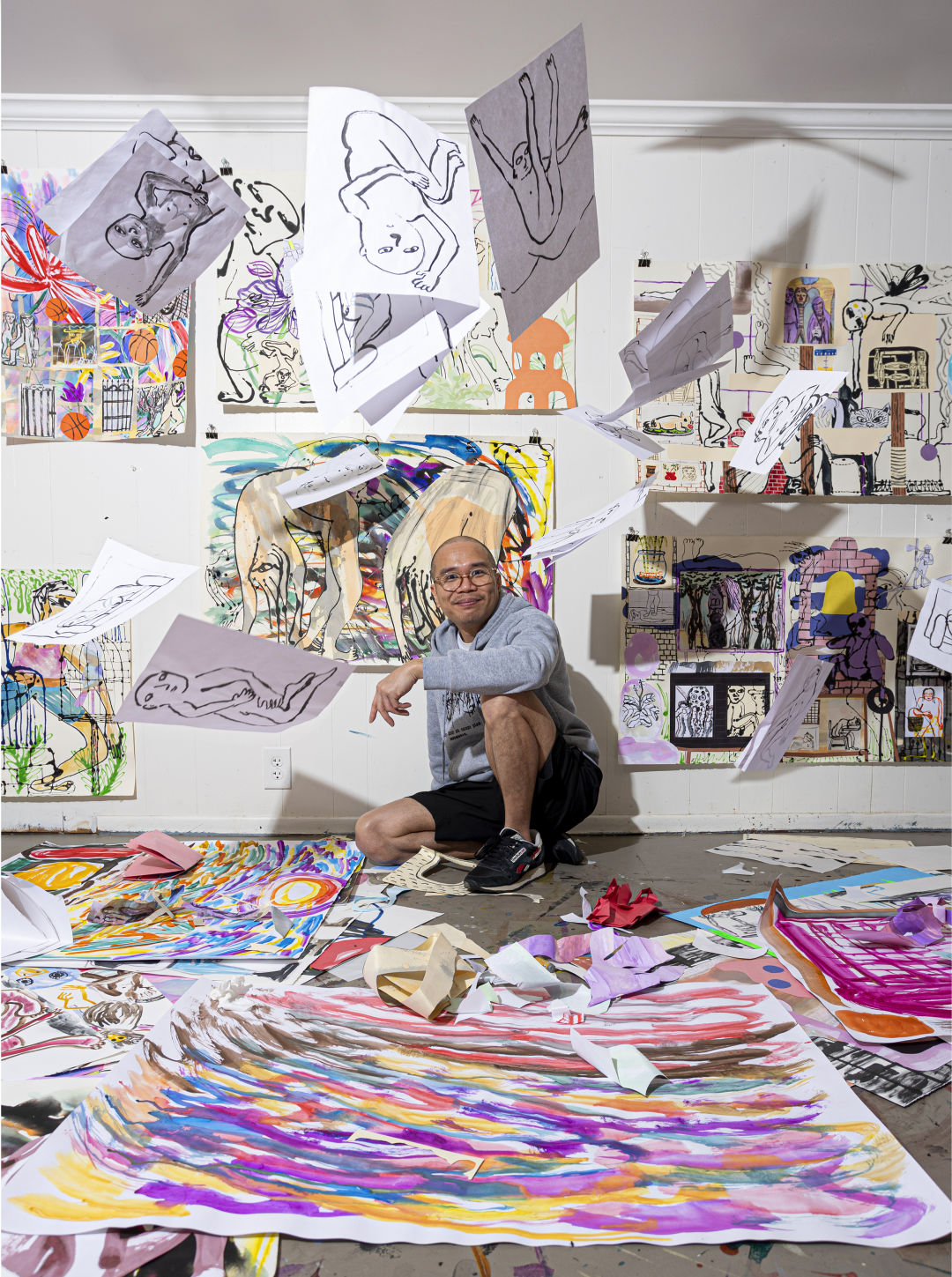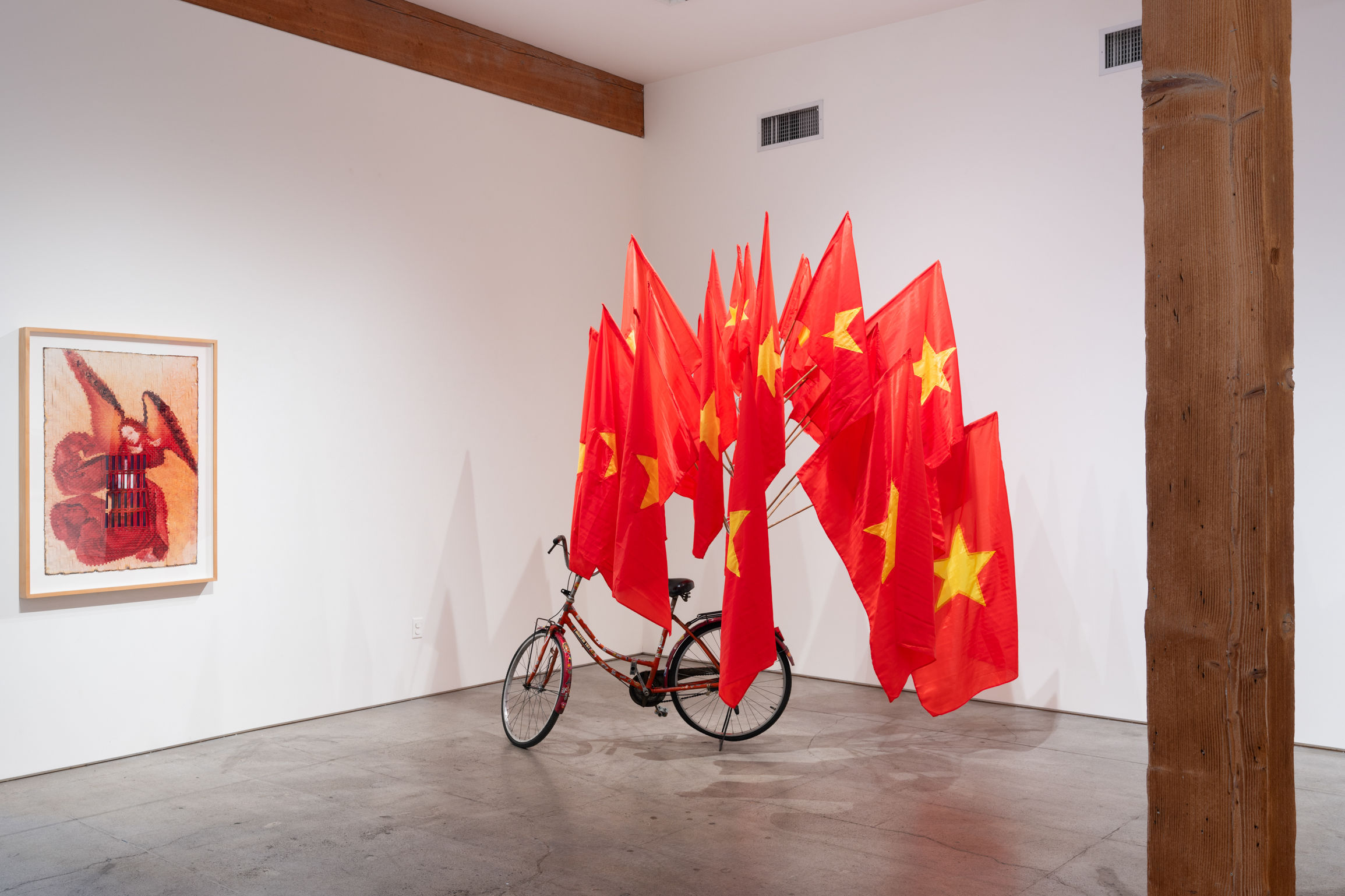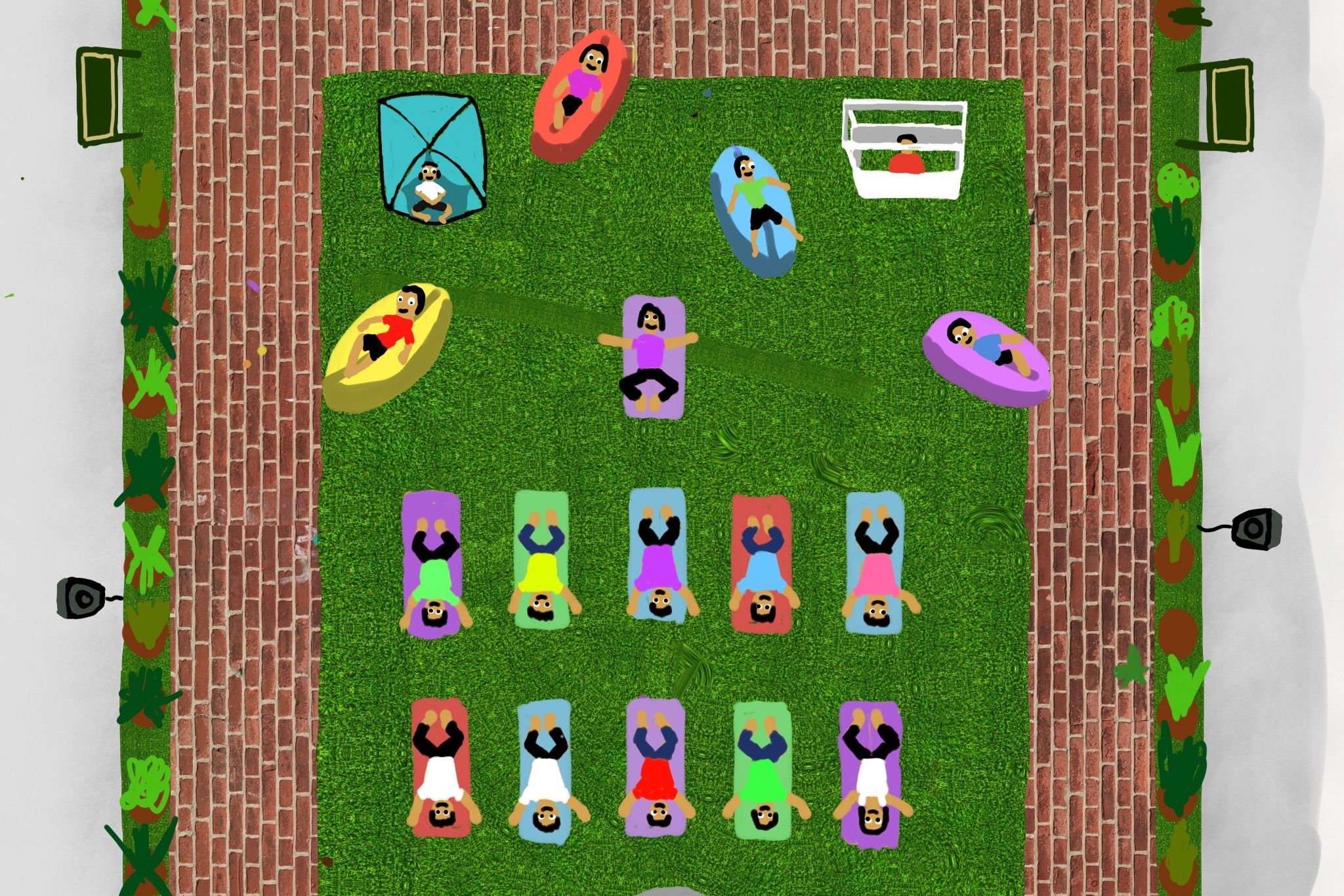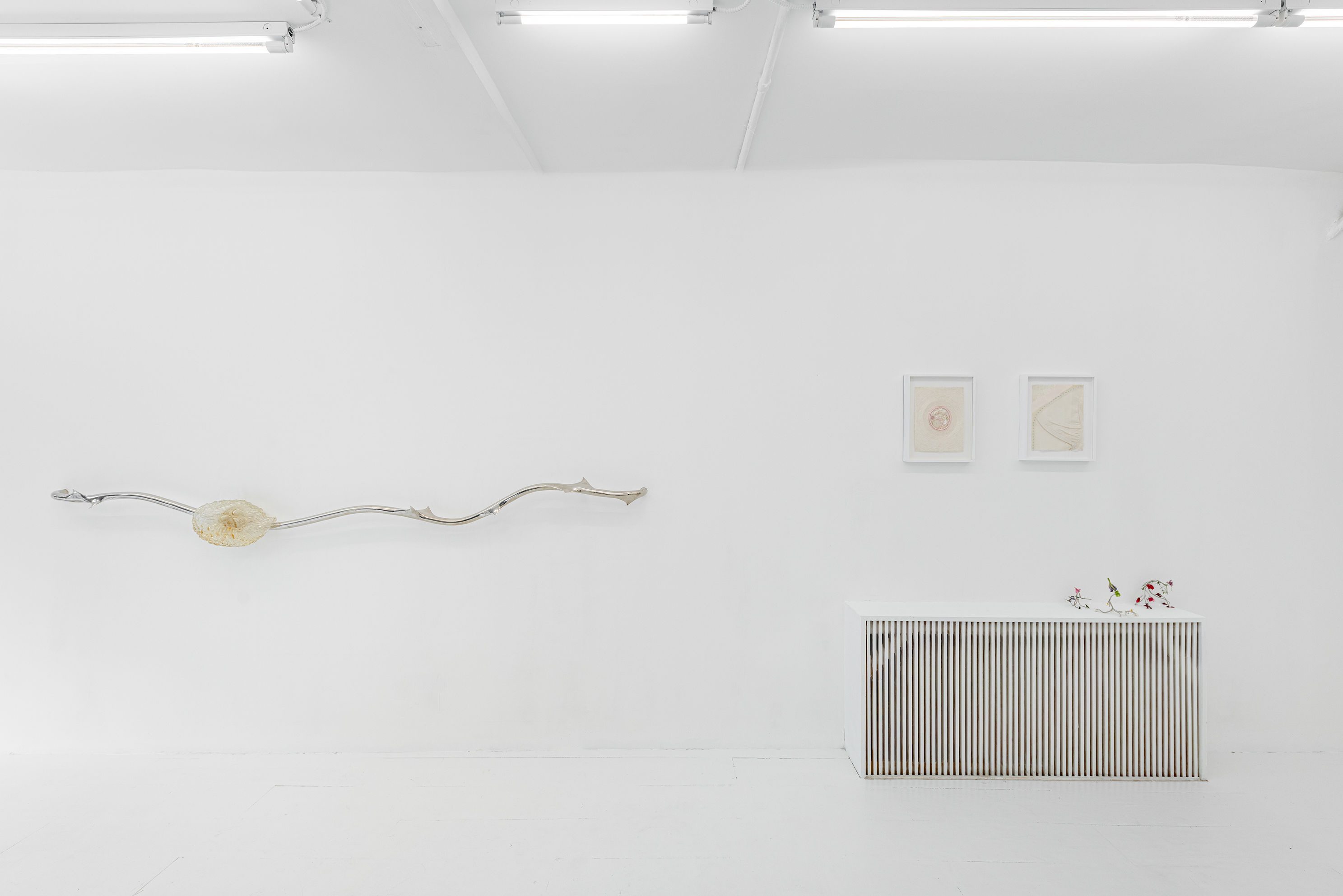Ralph Pugay Is Troubling Paradise

Image: Michael Novak
Ralph Pugay puts things where they don’t belong. His paintings revolve around witty, cartoonish juxtapositions: vampires at the gym, a “meditation contest” with corporate sponsorship. They collapse time and geography, lines between fact and fiction and holy artifacts and internet garbage. In Sarcophagus Workshop, from 2023, ancient Egyptians decorate coffins as if attending a hobby class. But these are slippery jokes. As the laugh burns off, the odd pairs pose questions that, because they’re difficult to summarize or reduce to simple arguments, tend to stick with you.
The artist Pat Boas, Pugay’s friend and former professor at Portland State University, recently recalled a painting from 2014 of a frying pan loaded with butterflies. Despite the grim setup, “It’s kind of, like, lovely,” Boas told me. The joy is that you can’t really say why. “It’s making these conjunctions that don’t—they refuse to meet up,” Boas said. “They won’t make sense, and they’re fine with that.” Instead, they work like queer allegories, animated by repurposed biblical tropes, viral TikToks, and allusions to video games. For instance, while you could read Gym of the Night as a quip about nocturnal fitness, Boas went on, “a vampire is just a particular, weird stand-in for a whole lot of other situations in which people at the extremes, or what we think of as the extremes, become normalized.”
His paintings abstract these instances past the bounds of autobiography, but the emotional kernel rings through. “I think that Ralph is making visible some of the background architecture and influences on our lives,” the gallerist Amy Adams told me. “Whatever scene he’s setting up is an absurdity. But you talk to him and it’s, like, something that he’s experienced in real life.”
Adams’s gallery, Adams and Ollman, has hosted Pugay’s two most recent shows. Paintings made up most of The Longest Journey, in 2023, but that show also featured a large installation of drawings, which were themselves situated within a mural painted directly on the gallery wall. Pugay’s drawings are raw and unfiltered compared with his paintings. They similarly pull moments from life, but deliver them untranslated, so to speak. The simple, quickly dashed-off memories and observations are based in emotion instead of concepts. Speed imparts an intense honesty, as if the artist had no time to compose or alter his thoughts while illustrating them.

Image: Courtesy Adams and Ollman
Pugay’s current show, ShangriLIEF (through December 20), is made up entirely of drawings—individual pictures, a site-specific installation similar to the one from 2023, and collages that wiggle with immediacy; the latter almost resemble sections harvested from the temporary installations. “Paper is a trace of something, a trace of an idea, or a doodle or a note—you know, a record,” Adams said. “It makes sense that he’s working in this way as he’s, like, gathering evidence of the absurdity of our everyday lives.”
Soon after Pugay immigrated to the US from the Philippines, in the late 1990s, his childhood home was bulldozed. He was 14, old enough to have banked countless sensory memories, but just as the joys, traumas, and banalities of life began to take shape as an understanding of himself, everything he’d known disappeared. Even family photos were mostly lost in the move. The Philippines was reeling from financial collapse during his childhood, and rebuilding itself after the People Power Revolution of 1986, which ended a dictatorship and two decades of martial law. Most of Pugay’s relatives had fled to the US by the time his immediate family left, and he hasn’t been back to the small fishing town, Rosario, in the Cavite Province, since.
He spoke English fluently by the first grade. In the States, communicating facts wasn’t a problem, he told me, “but there’s still cultural nuances that you miss out on, and it can feel somewhat queasy to experience.”
Pugay left the Bay Area, where his family settled, for Portland after high school and fell backward into art school. On public transit, in episodes of King of the Hill, at the gym—everywhere, he noted the fudged logic undergirding society. Making funny pictures about the untenable norms and exclusionary social cues he observed was a way of sorting out these puzzles, and eventually of sharing his vantage on the many facets of life that pretend to make sense: normalized prejudices, casual racism and homophobia, the ways collective ignorance perpetuates divides between species and socioeconomic classes. For instance, the 2018 painting Crazy Rich Turtles depicts exactly that.
Swapping characters and situations shocked the dailiness out of marginalization. Yet however self-aware, Pugay began to chafe at the reductive nature of parody. In a painting from 2018, a Grinch-like merman tans his scaly green butt on a cigarette-peppered beach. The title, A Creature Open to Metaphors, seems to state Pugay’s ambivalence out loud. “You’re objectifying yourself,” Pugay said. “Now I have a stomachache doing it.”

Image: Courtesy Adams and Ollman
In more recent drawings and collages, the same affecting imagery wavers between laughs and poignant reflection, insisting the viewer do both. But skipping the quippy, legible jokes that hold the paintings together offers a frenzied, life-like effect. Instead of trying to make sense of life, they embrace the ways life doesn’t make sense. The collages are distinctly personal, which you feel looking at them, though it would be impossible to “read” them precisely without Pugay’s explanation.
Thematically, ShangriLIEF looks back to Rosario, to Pugay’s childhood. Rather than recreate lost snapshots, he says he’s after the “flavored essence of them.” It’s more like writing his childhood into his present than retracing the past.
ShangriLIEF references the fictional utopia, Shangri-La, from James Hilton’s 1933 novel, Lost Horizon. Pugay catches on the many ways the dream of a lost paradise has been co-opted by wellness branding—Amazon schlock, resort chains, and countless other instances of commodified paradise—as something exempt from compromise or contradiction. His answer is to name paradise, or happiness, as intangible and ever-changing. Certainly, it’s not salable. And he refuses tidy parody, instead nakedly portraying his own memories in fragmented panoramas. Happiness is a posture, a mindset, not an elusive haven to seek out—a point Pugay makes in portraying his past as both idyllic and traumatic. “Fracture” is the single-word answer he gave when asked about the logic behind the collages.

Image: Michael Novak
Garden of Dissociation (Angry Phlebotomist) is a kind of timelapse daydream. Pugay’s mother’s orchids—in soft magenta, violet, and coral tones—weave around a paper cutout of a garden lantern. His child self languorously perches on the favorite branch of a mango tree. Pasted into the same collage is a rectangular drawing of a man posed nude, arms flexed overhead, as one might on a dating app profile. In another phone-like rectangle, a syringe prods an arm, suggesting an STI test. It’s a sweet, gleeful, and mischievous picture of what being queer meant as the child of a country and family organized by Catholic faith, in which homosexuality was a sin but not a crime, and what it means today in Portland.
In another collage, Climbing the Belltower, the inky black outline of a figure stands atop a brick structure. The climber flickers between the collage’s layers, the way a memory softens if you try too hard to bring it into focus. Beside the tower, a construction worker carries away a tree branch. A hibiscus bloom floats in pink bubbles elsewhere, like the ones kids in the Philippines make with the slimy, crushed flowers, like blowing soap bubbles. Then lines of screenshots and snapshot memories dissolve. Someone gets an ashiatsu massage. A ghost is trapped in a vending machine. A hand holds out a freckly squid. Two boys cuddle in bed, while a man in a hat points disapprovingly and another glowers from above.
It’s the overwhelm of the present, scrolling, clogged with optimizing technology. It’s the complexity of a love that’s endured hurt and sacrifice, which is to say, any love. It’s a broken logic arguing that all logic is broken. It’s a human person existing. “There’s like a—what do you call it? Like an energetic rhythm,” Pugay eventually added to his note about fracture. “Depending on what’s going on with my day, it could either be funny, or sad, or just OK.”




